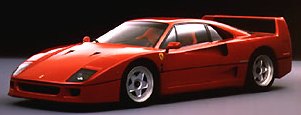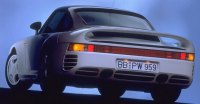The
arch-rival :
Ferrari F40


Undoubtedly,
the most obvious rival of Porsche 959 was Ferrari F40. Just one year
after
Porsche started delivery 959, Enzo Ferrari unveiled F40 in Maranello,
aiming
to re-clinch the "Fastest car" title from Porsche. If we say the
Porsche
was built on Group C technology, then Formula One must be the donor of
the Ferrari.
In specifications,
the Ferrari
was even faster than 959. Its 2.95-litre twin-turbo V8 produced 28 more
horsepower and 56 lbft more torque. In basic trim, it weighed just 1100
kg, thanks to the tubular space frame chassis and full carbon fiber
body.
Even adding winding windows and air-con like most customers did, it
still
weighed less than 1,200 kg, well below Porsche's real kerb weight of
1,530
kg.
Although F40's
aerodynamic drag
coefficient was higher than 959 (0.34 versus 0.31), it was recorded a
top speed of 199 mph and 202.5 mph respectively by Auto Motor und Sport
and Quattroroute magazine, eclipsing 959's 197 mph recorded by AMS. In
terms of acceleration,
959 won in the earliest stage since its variable 4-wheel drive
eliminated
tyre slip during starting and made better use of traction. Therefore it
could beat the Ferrari in 0-60 mph (3.6 sec versus 3.9 sec), but there
after the Ferrari's true power started to display its superiority and
it
never look back until limited by drag. Here is their acceleration
figures:
Testers
Walter Brun
: ex-racing driver and racing team boss who was running the successful
EuroBrun Racing. He drove his Porsche 956 and 962 in Group C endurance
world championship. The 959 featured in this test was his own everyday
car.
Gerhard Berger
: everybody knows he was one of the top Formula One drivers for many
years.
In 1988, he served the Ferrari F1 team and by the way participated in
the
testing of F40. He was invited by the company to demonstrate the F40 in
this contest. He also bought a F40, but not yet delivered until
September
of that year.
Test Track
Ferrari's Fiorano test
track,
Maranello, Italy. This is a small track with many tight corners.
Test Car
The 959 under test was a
Comfortable
version. Since only 6 Sports version were made, compare with about 200
Comfortable version, it is very reasonable to use the 959 Comfortable
as
representative of the whole 959 range. The F40 was the original
unmodified
one, without winding windows and air conditioning.
Start testing now ...
"I
have
driven so many Porsches, and all the racers including the 956 and 962,
" Brun said as we headed south for Modena. " I had to have a 959 for
the
road. " There was a sparkle in his eyes at the prospect of what lay in
store : we were going to be the first to find out what happens when you
pit the technical might of the Porsche 959 against the comparatively
simple
but even move potent Ferrari F40.
Having
arrived Maranello, Brun and Autocar's Malte Jurgens parked the white
959
in front of Cavallino restaurant and went inside to have a tea. People
became curious. One finally asked what we were doing. " Waiting for
Gerhard
Berger and a Ferrari F40, " Brun replied.
A
few
minutes later, the white 959 rolled through the gates of Ferrari's holy
of holies. Enzo Ferrari's son Piero Lardi seemed interested and came up
on a cross-country Honda. Some of the race team stayed to watch too. (Note
: the F1 team had already finished testing in the track)
Then Berger strolled up and climbed into the F40 that was awaiting his
pleasure. I dropped into the seat beside him.
"
It
runs fantastically well. It bites from around 3000 rpm and upwards of
3500
it really takes off as if the turbos are constantly supplying with full
boost, " said Berger.
Beyond
3500 rpm, there is such an abundance of power and torque that Berger
had
power oversteer any time he felt like it.... while all this was going
on,
the F40 stayed as flat and felt as taut as a racing car. There was no
impression
of the wheels rising and falling to absorb irregularities in the
surface
; more as if it was doing it with its whole body. This suited Berger. "
I like hard-tuned suspensions, " he said, " and the F40 has the best
road
chassis I have ever driven. "
The Ferrari seemed to
suck in
the tarmac ribbon of the test track so fast that at the end of the
short
straight at Fiorano, the Jaeger speedo was showing almost 160 mph. The
959's speedo would show 138 mph at the same point.
When
we were out on the track again, with Berger now pitting the 959 against
the curves that the Ferrari had just attacked, it was clear that in its
engine characteristics the 959 is the more radical of the two. Its
two-stage
turbocharging system gives it performance that is more typical of a
blown
engine.
Up
to 4300 rpm, only the first turbo puffs into the cylinders of the flat
six with its water-cooled heads ; above that, the second blower ( which
has already started spinning, thank to the elaborate bypass plumbing )
comes in. This makes the Porsche feel rather leisurely below 4500 rpm.
Then it suddenly explodes as it begins to dispense real power. Its
maximum
torque of 369 lbft comes at 5500 rpm ( against F40's 425 lbft at 4000
rpm
) which is why the 959's six-speed transmission wants to be operated
quickly.
The Ferrari makes do with five gears.
A
few
laps of Fiorano soon showed what the Porsche, despite its open-road
prowess,
couldn't do : sweep around corners quite as swiftly and adroitly as the
F40. On this track, especially in the tighter bends, the Ferrari's
ability
to be driven mroe aggressively on the throttle helped make it superior.
Apart from its power-to-weight edge, the F40's better weight
distribution
of almost 50 : 50 front to rear (compared with the 959's 42 : 58) makes
it a perfectly-balanced car which, despite its longer wheelbase (96.5
in
to the 959's 89.4), could snake around the tighter bends.
By
comparision, the 959 struggled through the cuit's curvier sections.
This
calls for an explanation. The 959 is designed to run with its drive
biased
towards the rear. Then, as soon as the rear wheel sensors detect a
tendency
to spin, the front-wheel drive is progressively activated until a power
distribution of 50 : 50 front and rear has been reached.
Walter
Brun remembers being told by Porsche that the 959 can easily be pushed
into oversteer on dry tarmac by turning in sharply and stepping on the
throttle. This was not the case at Fiorano. The
959's engine characteristics, its weight and its four-wheel drive
arrangement
made it the inferior car on the smooth dry tarmac of the circuit.
The
Porsche is based on the galvanised sheet steel construction of the 911.
With comfort aspects like electrically adjustable seats and its heavy
four-wheel
drive, some models tip the scales at just under 3500 lb instead of the
the 2970 lb specified by Porsche and the 2425 lb of the F40. These
masses
need to be accelearted and braked which, together with the four-wheel
drive
- not set to respond in the sportiest way - results in a handicap the
959
cannot overcome on a dry track.
"At Fiorano, the 959 is
at least
10 secs behind the F40," Gerhard Berger said - and even 959 owner
Walter
Brun would admit to six.
By
the time Walter Brun took over the F40 he had consistently run the
Porsche
to its limits. In the F40, he easily matched the speed Berger had
posted
in the 959. (Note: remember Berger's
superior
driving skill) "The F40 is very easy to
drive,"
Berger explained. "If you are experienced with racing cars, you will
find
it very easy to handle the Ferrari." Brun's judgement, too, is based on
his racing car experience : "The F40 runs nearly as well as my Porsche
962. With racing tyres and some fine tuning it would easily run at the
front of category C2 (Note: FIA endurance racing Group C
category
2, slightly lower than Porsche 962.) Berger
chipped
in again : "It is nearly an act of provocation to offer a car with so
much
power and so little weight to an ordinary driver."
But
there is another side to all this. The F40's advantage is clear when
the
sky is blue and the tarmac fairly smooth. The 959, however, is a car
which
permits massive acceleration and deceleration even on wet surfaces,
slush
or gravel. The Porsche, with its interior noise levels reduced allows
just
a rumble of the staccato of its firing order into its cabin, whereas
the
F40 smacks at you with each rev. The hoarse howl of the Ferrari V8 is
so
dominant that very wisely there is no space for a radio in the
dashboard.
"The 959 is a civilised
two-plus-two
with amazing driving performance," Berger and Brun agreed. "The F40 is
a racing car for the road."

